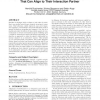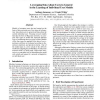2078 search results - page 12 / 416 » Using Aspects to Make Adaptive Object-Models Adaptable |
MIDDLEWARE
2007
Springer
14 years 1 months ago
2007
Springer
Pervasive devices are becoming popular and smaller. Those mobile systems should be able to adapt to changing requirements and execution environments. But it requires the ability t...
ATAL
2010
Springer
13 years 8 months ago
2010
Springer
Speakers in dialogue tend to adapt to each other by starting to use similar lexical items, syntactic structures, or gestures. This behaviour, called alignment, may serve important...
ISCA
1998
IEEE
13 years 12 months ago
1998
IEEE
Pipeline flushes due to branch mispredictions is one of the most serious problems facing the designer of a deeply pipelined, superscalar processor. Many branch predictors have bee...
IJCAI
2001
13 years 9 months ago
2001
Models of computer users that are learned on the basis of data can make use of two types of information: data about users in general and data about the current individual user. Fo...
CVPR
2005
IEEE
14 years 9 months ago
2005
IEEE
Projection systems can be used to implement augmented reality, as well as to create both displays and interfaces on ordinary surfaces. Ordinary surfaces have varying reflectance, ...



